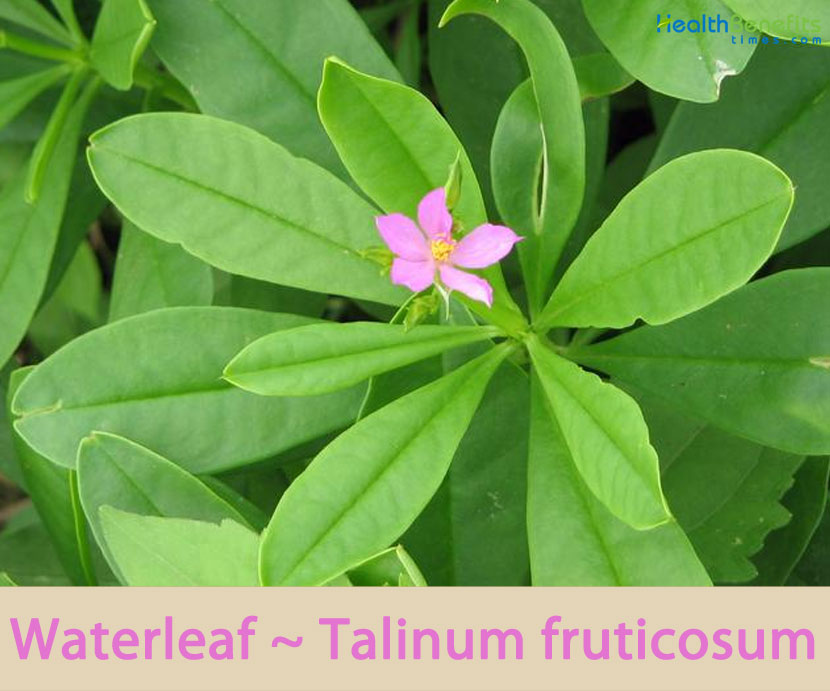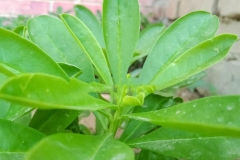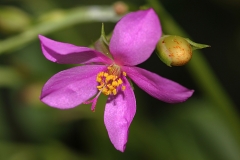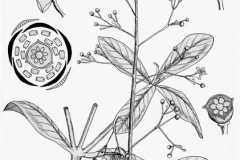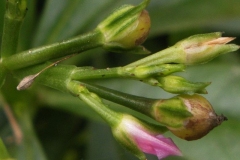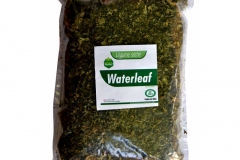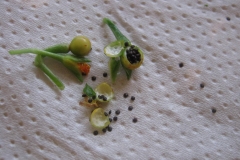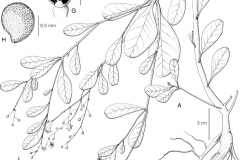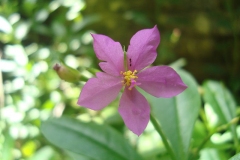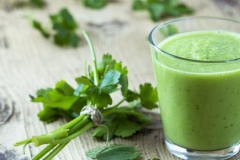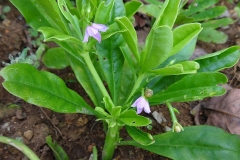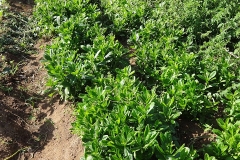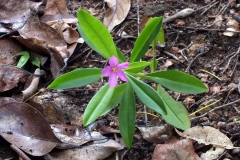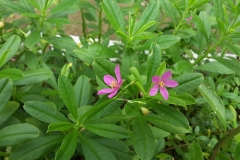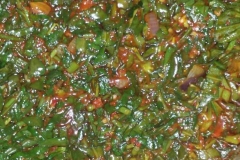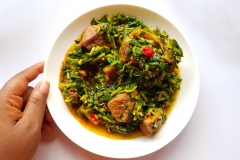| Waterleaf Quick Facts | |
|---|---|
| Name: | Waterleaf |
| Scientific Name: | Talinum fruticosum |
| Origin | Mexico, the Caribbean, Central America, much of South America |
| Colors | Pale yellow |
| Shapes | 3 angled; globose or subglobose capsules, about 5 mm in diameter and 6 – 7 mm long |
| Health benefits | Promotes Heart Health, Prevents cancer, Helps in Digestion, Eliminates Infections & Diseases, Good for Weight loss, Strong Bones and Teeth, Promotes Eye Health, Enhances Cognitive Ability, Improves Blood Clotting, Prevents Atherosclerosis, Improves the Blood Cells, Manages Blood Pressure, Prevents Cataracts, Promotes Good Skin, Beneficial in Pregnancy, Manages Blood Sugar |
| Name | Waterleaf |
|---|---|
| Scientific Name | Talinum fruticosum |
| Native | Mexico, the Caribbean, Central America, much of South America. It is cultivated in West Africa, South Asia, Southeast Asia, and the warmer parts of North and South America. In Bolivia it is known from Beni, Chuquisaca, Cochabamba, La Paz, Santa Cruz and Tarija |
| Common Names | Ceylon spinach, Fame flower, Philippine spinach, Potherb fameflower, Surinam purslane, Sweetheart, Waterleaf, Florida spinach, potherb fameflower, Cariru, Lagos Bologi, Gbure, Florida spinach, Surinam spinach |
| Name in Other Languages | Afrikaans: Waterleaf Albanian: Waterleaf Amharic: Yewiha tenit’elit’ayi (የውሃ ተንጠልጣይ) Arabic: Naba at alma (نبات الماء) Armenian: Jrbazhan (ջրբաժան) Azerbaijani: Sudan yarpağı Bengali: Waterleaf Brazilian: Cariru Bulgarian: Waterleaf Burmese: Raytanhkwan (ရေတံခွန်) Cameroon: Bolki, Belok sup Chinese: Shuǐ yè (水叶), Do ninjin (棱轴土人参) Croatian: Waterleaf Czech: Waterleaf Danish: Waterleaf, Trekanttalinum Dutch: Waterblad, Surinaamsche postelein, Surinaamse postelijn English: Waterleaf, Ceylon-spinach, Philippine-spinach, Surinam-purslane, Verdolaga-Francesa, Sweetheart, pink purslane Esperanto: Akvujo Estonian: Vesileht Filipino: Waterleaf Finnish: Waterleaf French: Feuille d’eau, Grand pourpier, Grassé, Grassé grand pourpier, Pourpier tropical, Talina de Java, grand pourprier, pourpier grand bois, Georgian: Ts’q’lists’q’ali (წყლისწყალი) German: Wasserblatt, Blatt-Ginseng, Ceylonspinat, Javaspinat, Ghana: Busummuni, Adwere, Boroboro, Senuma Greek: Ydróvia fýlla (υδρόβια φύλλα) Gujarat: Vōṭaralīpha (વોટરલીફ) Hausa: Bawan ruwa Hebrew: עלה Hindi: Waterleaf, Pasali, Samparchera Holland: Surinaamsche postelein, Surinaamse postelijn Hungarian: Waterleaf Icelandic: Vatnsblaði Igbo: Mgbolodi Indonesian: Selada air, Krokot belanda, Kolesom, Poslen Irish: Duilleog uisce Italian: Hydrophyllum, Basella di giava, Spinacio di giava, , Spinacio di Suriname Japanese: U~ōtārīfu (ウォーターリーフ), hazeran (ハゼラン) Javanese: Banyu, Ginsèng jawa Kannada: Vāṭarlīph (ವಾಟರ್ಲೀಫ್), Nelabasaḷe (ನೆಲಬಸಳೆ) Kazakh: Sw japırağı (су жапырағы) Korean: Mul-ip (물잎) Kurdish: Silava avê Lao: Waterleaf Latin: Waterleaf Latvian: Udenslauks Lithuanian: Vandenlente Macedonian: Voda bez voda (вода без вода) Malagasy: Waterleaf Malay: Air terjun, Krokot belanda , Poslen, Pokok Kolesom Malayalam: Vāṭṭarlīph (വാട്ടർലീഫ്), sāmpār cīra (സാമ്പാർ ചീര) Maltese: Waterleaf Marathi: Votaraleeph (वॉटरलीफ) Mongolian: Usan khalisan (усан хальсан) Nepali: Vāṭaralīpha (वाटरलीफ) Nigerian: Lagos bologi, Gbure, Ntuoka, Ikpibi Norwegian: Waterleaf Oriya: ଜଳପ୍ରବାହ Papua New Guinea: Kumu manus Pashto: واټرلیف Persian: بی آب Philippines: Talilong, galaghati, biala Polish: Waterleaf Portuguese: Folha de água, Beldroega-graúda, Lustrosa-grande, Espinafre de Ceilao, cairu Punjabi: Vāṭaralīpha (ਵਾਟਰਲੀਫ) Romanian: Waterleaf Russian: Waterleaf Serbian: Vodopad (водопад) Sindhi: پاڻي وارو Sinhala: Diya ælla (දිය ඇල්ල) Slovenian: Vodni list Spanish: Hoja de agua, Espinaca de Filipinas, Espinaca de Java, Espinaca de Surinam, Verdolago francés, verdolaga blanca, verdolaga de castilla, verdolaguilla, verdolaga de playa Sri Lankan: Gasnivithi Sudanese: Waterleaf Swedish: Waterleaf Tajik: Tarʙuz (тарбуз) Tamil: Vāṭṭarlīḥp (வாட்டர்லீஃப்), Sambar keerai (ஸாம்பார் கீரை) Telugu: Waterleaf Thai: Waterleaf, Som chin (โสมจีน), Som kaoli (โสมเกาหลี ), Som khon (โสมคน) Turkish: Waterleaf Ukrainian: Vodyanyy lyst (водяний лист) Urdu: واٹرلیف Uzbek: Suvli barg Vietnamese: Lá nước, Th[oor] nh[aa]n s[aa]m Welsh: Dail dŵr Yoruba: Gbure, Ajigborere, alawere Zulu: Amanzi |
| Plant Growth Habit | Small, short-lived, erect, strongly branched, perennial plant |
| Growing Climates | Common in plantation crops, roadsides, shaded areas, waste places, forests edges, Yungas forest, dry chaco forest, open woodland, pinelands, hammocks, and disturbed areas |
| Soil | Prefers a well-drained but moist, humus-rich fertile soil, though it will succeed in relatively poor soils |
| Plant Size | 30 to 100 cm (12 to 39 in) tall and a width of 50 centimeters |
| Root | Swollen and fleshy |
| Stem | Circular, fleshy , little branched, with alternating phyllotaxis from the base and verticilated phyllotaxis just below the inflorescence |
| Leaf | Arranged spirally almost nearly opposite, often crowded at the top of the stem and indistinctly or with petioles 2 –10 mm long |
| Flower | Flowers are bisexual and it is a measure about 0.5-2.5 cm in diameter. The pedicels elongate after anthesis |
| Fruit Shape & Size | 3 angled; globose or subglobose capsules, about 5 mm in diameter and 6 – 7 mm long |
| Fruit Color | Pale Yellow |
| Seed | Numerous, compressed spherical-kidney-shaped, with a size of measure about 0.8-1.2 mm long, granulate, smooth, brown or blackish |
| Propagation | By Seed |
| Plant Parts Used | Juice, stem, leaves, and roots |
| Health Benefits |
|
| Other Facts |
|
| Precautions |
|
Plant Description
Waterleaf is a small, short-lived, erect, strongly branched, herbaceous perennial plant that normally grows about 30 to 100 cm (12 to 39 in) tall and a width of 50 centimeters from swollen, fleshy roots. The plant is found growing in plantation crops, roadsides, shaded areas, waste places, forests edges, Yungas forest, dry Chaco forest, open woodland, pinelands, hammocks, and disturbed areas. The plant prefers well-drained but moist, humus-rich fertile soil, though it will succeed in relatively poor soils. Stem is circular, fleshy, little branched, with alternating phyllotaxis from the base and verticilated phyllotaxis just below the inflorescence.
Leaves
The leaves are arranged spirally almost nearly opposite, often crowded at the top of the stem and indistinctly or with petioles 2 –10 mm long. The leaf-blades are usually spoon-shaped, with a size of measure about 3-15 cm long and 1-6 cm wide, entire and succulent, obtuse to round and occasionally notched at the apex.
Flower
The inflorescence is a long peduncled, terminal, corymboid thyrsus, with a size of measure about 5-30 cm long, with a 2-5 erect, sharply triangular axes where each with 8-28-flowered. The flowers are bisexual and it is a measure about 0.5-2.5 cm in diameter. The pedicels elongate after anthesis. There are 2 sepals, about 5-7 mm long, needle-pointed, free, green in color and persistent. The 5 pink petals are obovate in shape and up to measuring 10 mm long and 4 mm wide. The stamens are 20-40. The style is 2-3-fid while the ovary is superior. Flowers open during the day from 09 to 16 hours.
Fruit
Fertile flowers are followed by 3 angled; globose or subglobose capsules opening by three separate valves; valves are usually caducous, intervalvular membrane and filament absent. They are pale yellow colored and about 5 mm in diameter and 6 – 7 mm long that is explosively dehiscent, and scatters the tiny black seeds over quite an area.
Seeds
The seeds are numerous, compressed spherical-kidney-shaped, with a size of measure about 0.8-1.2 mm long, granulate, smooth, brown or blackish and superficially reticulate, the surface being covered with small, irregularly arranged papillose protuberances, these denser towards the margins; membranous caruncle are absent.
Health benefit of Waterleaf
Waterleaf vegetable consists of lots of water and nutrients such as minerals, vitamins, crude fiber, lipids, crude protein and others which make them nutritious and medicinal in several ways. Listed below are some of the popular health benefits of using waterleaf
1. Promotes Heart Health
When consumed on a daily basis, waterleaf performs a key role in maintaining the cardiovascular system. It helps to keep the heart healthy by regulating the activities of the heart and decrease the risk of related heart diseases as well as stroke by sufficiently supply of blood and oxygen to the needed areas. It also helps in decreasing the cholesterol levels in the blood, which is good for the prevention and improvement of heart-related conditions.
2. Prevents cancer
Consuming waterleaf has the extraordinary benefit for preventing cancer. Cancer is a disease that attacks normal cells, belonging to deadly diseases in the world. Many cancer patients cannot be cured with a total of many that lead to death. So, one way to prevent cancer is to consume waterleaf regularly.
3. Helps in Digestion
Waterleaves are an excellent vegetable that is 100% healthy for the body even when consumed together with the stem which helps to decrease constipation and aid in proper digestion of food.
Problems with indigestion seem to alleviate when waterleaf is eaten and helps to soften the stool as well but when eaten in excess can cause a little stomach discomfort.
4. Eliminates Infections & Diseases
Waterleaf consists of antibacterial, antifungal and anti-inflammatory properties that help to suppress the growth of bacteria, fungi and inflammatory diseases in the body. It has been proven effective for the treatment of Atherosclerosis which results as the arteries in the body is been gathered with fats and cholesterols thereby making the walls of the artery to be narrow. This makes the blood flow to be interrupted and can even cause a total blockage in the artery thus leading to many health conditions like stroke, heart attack and more.
Waterleaf consumption has been locally used in the treatment and prevention of this health condition, for more effective results, the leaf should be washed and properly squeezed to extract the juice which has to be taken orally. There is no measurement for the quantity of waterleaf juice to be taken but it should be moderate.
5. Good for Weight loss
Waterleaf serves as a weight loss diet due to the amount of fiber content in it. But it should be taken on a regular basis either used in a salad or steamed to a certain temperature.
Fiber content makes the stomach fuller thus removing the chances of craving for more food, its water content also helps in this case, which makes it one of the vegetables to be added to our daily meal for proper weight management. It helps to improve weight; we have to also eat healthy at all times for the effectiveness of this nutrient.
6. Strong Bones and Teeth
The presence of calcium in this vegetable helps in maintaining strong bones and teeth. In general, it gives support to the body skeletal structure and improves skeletal function. Calcium is very vital in the formation of bones in the body, and the content of this mineral in waterleaf makes it one of the foods suitable for those who have osteoporosis, fracture, and more, as it can help in its improvement.
7. Promotes Eye Health
Waterleaf consists of good amount vitamin A which helps to enhance vision in poor light and as well helps in the improvement of the skeletal tissue and the skin due to its content of vitamin A1 as known as Retinol. Vitamin A can help in providing the eye with the necessary nutrients which it needs to prevent some of the eye-related conditions like cataracts, macular degeneration and more. Therefore, the intake of waterleaf in the right amount will result in a healthy eye.
Waterleaf also consists of vitamin C which helps to maintain a healthy eye by preventing the retina from damages which might be caused by free radicals and other health conditions that affect the eyes like dry eyes, conjunctival hemorrhages, and even cataracts.
8. Enhances Cognitive Ability
Regular consumption of Waterleaf has a good effect on the cognitive ability because of the presence of certain constituents which helps to improve cerebral blood flow and cognitive function.
Due to its ability to improve the flow of blood, it helps the brain to function sufficiently by providing it with adequate oxygen as well in order to prevent/improve Cerebral Hypo perfusion, Schizophrenia as well as the death of the brain tissues.
Presence of iron in waterleaf helps also in the strengthening of the brain muscles and tissues which helps in the improvement of the human brain, thus improving the cognitive reasoning as well.
9. Improves Blood Clotting
Waterleaf has a great effect on the blood which makes it one of the vegetables which have to be incorporated into our daily meal due to its effectiveness. It helps in the improvement of blood clotting and prevents new ones from forming just like thrombus which might be formed in ones of the blood vessels interfering with the flow of blood.
Though thrombus can be termed healthy when it functions to stop bleeding on injuries by making the blood to form a clot but can be termed unhealthy when the clot formation tends to block the blood vessels. Therefore, the intake of waterleaf in whatever form can help prevent such occurrences and even help improve existing ones due to their anti-inflammatory properties and others.
10. Prevents Atherosclerosis
Atherosclerosis disease is a disease affecting the arterial wall where the growth of excess fat in the section. The growth of the fat in artery walls can cause obstructed blood flow and perfect flow to the brain and our heart. Thus, consume waterleaf may prevent atherosclerosis.
11. Improves the Blood Cells
The crude protein contained in waterleaf is an important supplement both in quality and nutritional perspective which plays a very important role in the human blood cell.
It functions when it comes to blood cells in the body can’t be exaggerated. It is believed to help in the adequate pumping of blood and its supply and as such is used in many cases such as in the treatment of anemia.
It generally helps in improving the blood cells which includes both the white and red blood cells, and with the content of iron as well helps in this case.
12. Manages Blood Pressure
If you are searching for home remedies to manage your blood pressure, waterleaf juice might be the beverage for you. The ideal amount of fiber and minerals present in the juice helps in the management of both the heart rate and the blood pressure. Regular consumption of waterleaf juice can help you prevent health issues like hypertension and cardiovascular problems.
13. Prevents Cataracts
Our eyes need vitamin C in order to function appropriately. Lack of vitamin C can cause cataracts, where the eye’s lens becomes increasingly opaque. Cataracts cause blurred vision and can end in blindness in adults. High intake of vitamin C will prevent cataracts because it will increase the amount of blood flow to the eye.
14. Promotes Good Skin
Waterleaf is a good source of vitamins A and C that aids the repair and growth of the body cells and tissues. The process results in healthy and beautiful skin. The antioxidants in the juice are an ideal solution to improve skin pigmentation and hydrate it. The juice keeps dryness at bay and gives you glowing healthy skin. Make sure, you drink waterleaf juice in moderation for the best results.
15. Beneficial in Pregnancy
Waterleaf is beneficial for pregnant women because of the presence of Omega 3 fatty acids and vitamins in the juice. As the juice boosts the blood level, it’s beneficial for both the mother and the baby. Juice also prevents health issues like anemia in the mother. Still, if you are expecting, you should always consult your doctor before making any changes to your diet. This is to understand if certain additions are required in your dietary preferences or not.
16. Manages Blood Sugar
High dietary contents of Waterleaf help to slow down the digestion and conversion of starch to simple sugars. It is worthy to note that this is essential for managing diabetes mellitus. It regulates the cholesterol level due to its high dietary fiber content. Research pointed out that Waterleaf is beneficial for regulating cholesterol level. This is because the dietary fiber reduces the absorption of cholesterol from the gut thus protecting the body from any disease associated with bad cholesterol in the body.
Traditional uses and benefits of Waterleaf
- The plant is used as a treatment for measles and diabetes.
- Tonic is made from the fleshy root.
- Waterleaf is most times called the “blood-pumping machines” as it plays a vital role in the sufficient production of blood in the human body.
- It is good for pregnant women as it helps increase their blood levels and as well, supply them with other vital nutrients that the body needs.
- Its juice, stem, leaves, and roots are all considered effective as they have proven successful in the treatment of measles.
- It can also treat insomnia, anemia, malaria, arthritis reduce blood sugar and blood pressure.
- It is also used in the treatment of diarrhea, improve weakness and more.
- Waterleaf helps to promote brain function, maintain skin health, and prevent cancer, bladder stone, and more.
- Crushed plant is applied as a poultice on contusion, inflammation and tumor.
- Decoctions are used for painful eyes and to aid recovery from blows and falls.
- Mostly the leaves can use in painful eyes and the roots as internal treatment.
- Mayan people applied crushed leaves on sores, inflammation, and swelling.
Culinary Uses
- Leaves and flowers can be used raw in salads or cooked.
- All parts, including roots, young shoots are used in making soups, stews etc.
- Combined with the leaves of eru and fufu, it is considered a delicacy.
- Best lightly steamed, they should not be overcooked or they will become excessively soft and mucilaginous.
- Leaves are used as a coloring agent in okra soup.
- The leaves have a slightly sour taste; they can be finely chopped and added to salads.
- They are used to prepare waterleaf soup, waterleaf stew or sauce, yam, salad and more.
- In the southern part of Nigeria, waterleaf is used in making special soup known as Edikang Ikong and Afang, Mgbolodi Soup and more.
- Leaves are used in the preparation of slightly slimy soups and stews to complement the starchy main dish.
- Fresh leaves and stems eaten raw or added to omelets, sandwiches.
- In many countries, it is used as a substitute for spinach.
- Tonic drink is made from the leaf ginseng root.
How to make Waterleaf Juice
Most people may not be versatile with waterleaf juice, as it is mainly used in cooking, serving as an important vegetable in many local cuisines in Nigeria. The juice of waterleaf is very beneficial to health and is useful in increasing the blood level and also in the treatment of many health conditions, which has proven successful.
To get the juice
- Wash the waterleaf thoroughly to remove dirt and sand
- Don’t pluck the leaves from the stem as both are medicinal and contain various degrees of nutrients.
- Cut it into tiny pieces to enable easy squeezing or pounding.
- Then squeeze effectively and strain the juice.
- Alternatively, a blender can do this work, but in case there is none, the above method should be considered.
References:
https://www.itis.gov/servlet/SingleRpt/SingleRpt?search_topic=TSN&search_value=508008#null
http://www.hear.org/pier/species/talinum_fruticosum.htm
https://npgsweb.ars-grin.gov/gringlobal/taxon/taxonomydetail?id=402262
http://luirig.altervista.org/schedenam/fnam.php?taxon=83418
http://tropical.theferns.info/viewtropical.php?id=Talinum+fruticosum
http://www.flowersofindia.net/catalog/slides/Ceylon%20Spinach.html
http://www.plantsoftheworldonline.org/taxon/urn:lsid:ipni.org:names:1182764-2
http://www.theplantlist.org/tpl1.1/record/kew-2513546
https://gd.eppo.int/taxon/TALFR
https://en.wikipedia.org/wiki/Talinum_fruticosum
https://www.cabi.org/isc/datasheet/110331
http://periodicos.ses.sp.bvs.br/pdf/rial/v68n3/v68n3a03.pdf
http://www.stuartxchange.org/PhilippineSpinach


